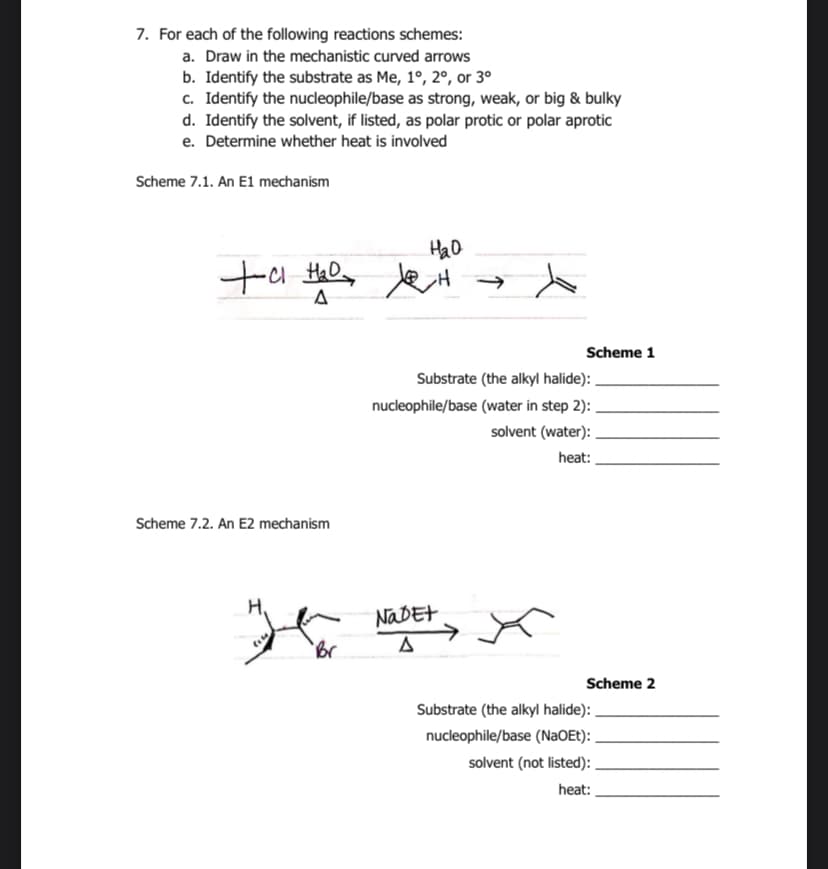7. For each of the following reactions schemes: a. Draw in the mechanistic curved arrows b. Identify the substrate as Me, 1°, 2°, or 3° c. Identify the nucleophile/base as strong, weak, or big & bulky d. Identify the solvent, if listed, as polar protic or polar aprotic e. Determine whether heat is involved Scheme 7.1. An E1 mechanism H₂O +-C1 H₂D JH → X A Scheme 7.2. An E2 mechanism Br Scheme 1 Substrate (the alkyl halide): nucleophile/base (water in step 2): solvent (water): heat: Nabet A Scheme 2 Substrate (the alkyl halide): nucleophile/base (NaOEt): solvent (not listed): heat:
7. For each of the following reactions schemes: a. Draw in the mechanistic curved arrows b. Identify the substrate as Me, 1°, 2°, or 3° c. Identify the nucleophile/base as strong, weak, or big & bulky d. Identify the solvent, if listed, as polar protic or polar aprotic e. Determine whether heat is involved Scheme 7.1. An E1 mechanism H₂O +-C1 H₂D JH → X A Scheme 7.2. An E2 mechanism Br Scheme 1 Substrate (the alkyl halide): nucleophile/base (water in step 2): solvent (water): heat: Nabet A Scheme 2 Substrate (the alkyl halide): nucleophile/base (NaOEt): solvent (not listed): heat:
Organic Chemistry: A Guided Inquiry
2nd Edition
ISBN:9780618974122
Author:Andrei Straumanis
Publisher:Andrei Straumanis
Chapter8: Addition Via Carbocation
Section: Chapter Questions
Problem 31CTQ
Related questions
Question

Transcribed Image Text:7. For each of the following reactions schemes:
a. Draw in the mechanistic curved arrows
b. Identify the substrate as Me, 1°, 2°, or 3⁰
c. Identify the nucleophile/base as strong, weak, or big & bulky
d. Identify the solvent, if listed, as polar protic or polar aprotic
e. Determine whether heat is involved
Scheme 7.1. An E1 mechanism
нао
to the le왜
+a
H₂D
A
Scheme 7.2. An E2 mechanism
Ho
Br
Scheme 1
Substrate (the alkyl halide):
nucleophile/base (water in step 2):
solvent (water):
heat:
Nabet
Δ
Scheme 2
Substrate (the alkyl halide):
nucleophile/base (NaOEt):
solvent (not listed):
heat:
Expert Solution
Step by step
Solved in 9 steps

Knowledge Booster
Learn more about
Need a deep-dive on the concept behind this application? Look no further. Learn more about this topic, chemistry and related others by exploring similar questions and additional content below.Recommended textbooks for you

Organic Chemistry: A Guided Inquiry
Chemistry
ISBN:
9780618974122
Author:
Andrei Straumanis
Publisher:
Cengage Learning

Organic Chemistry: A Guided Inquiry
Chemistry
ISBN:
9780618974122
Author:
Andrei Straumanis
Publisher:
Cengage Learning